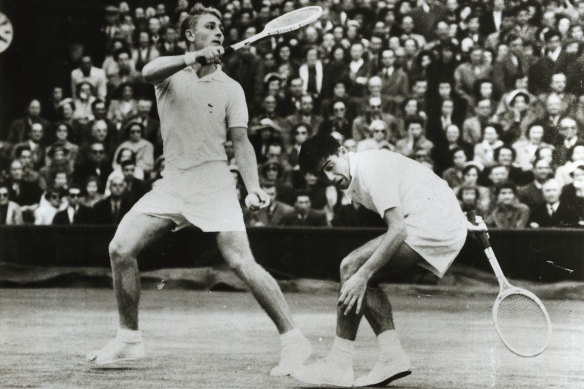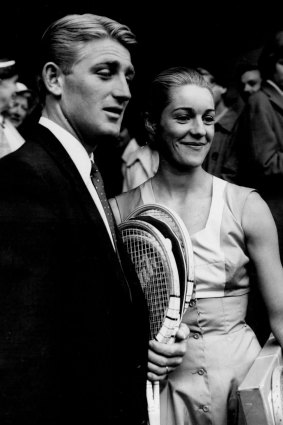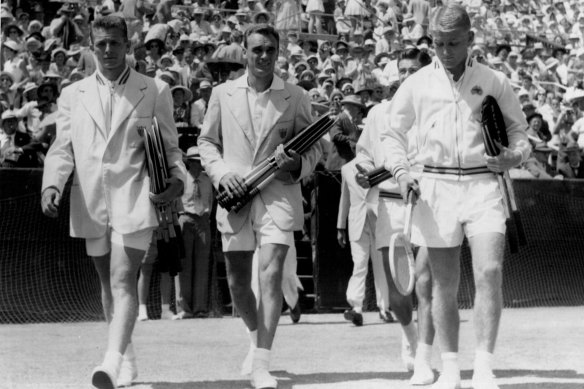By Staff reporter
This obituary was first published in The Sydney Morning Herald on 9 July, 1994
Lew Hoad, who died at his ranch on Spain's Costa del Sol on Sunday, was the blond trademark of the golden era of Australian tennis.

Lew Hoad and Ken Rosewall playing against Tony Trabert and Vic Seixas in the semi-final doubles at Wimbledon, 1954.Credit: Staff photographer
Only a few hours before his death, he had been talking animatedly about a planned tournament of some of his old mates who were to come to his tennis ranch later this month for a hit, a drink and a yarn - three of the great loves of Hoad's energetic life.
The strapping Sydneysider came to prominence as a teenager playing against a diminutive Ken Rosewall in a series of matches in the late 1940s and went on to become perhaps the best-known name in the long and distinguished history of Australian tennis.
Much of his fame was achieved with and against Rosewall, who was a lifelong friend and who was to be part of the get-together later this month. News of the severity of Hoad's illness - he had been suffering from leukaemia for some time - became known late last week.

Reigning champion, Lew Hoad, arrives at Wimbledon with his wife, June 24, 1957.
Paul McNamee, a Wimbledon doubles champion of a decade ago, had organised a reunion that would involve Rosewall, Manuel Santana of Spain, Roger Taylor of Britain and others. Hoad, making light of his predicament, said how much he was looking forward to it. The tournament will probably go ahead but the man it was to honour will not be there.
Lewis Alan Hoad was born in Glebe in 1934. He and Rosewall became the youngest Australians to represent their country in Davis Cup tennis when they were selected by their coach and captain, the legendary Harry Hopman, for the challenge round of 1952 at Melbourne's Kooyong courts.
When the reverse singles were played on the third day, Australia found itself down 1-2 against the formidable American pair of Tony Trabert and Vic Seixas. Trabert looked likely to defeat Hoad and secure the cup for the United States in the fourth match when Hoad slipped and fell on Kooyong's grass court. He lay there for an instant, apparently injured.
The wily Hopman strode across and threw a towel over his budding champion. He spoke a few words of encouragement. Hoad jumped to his feet and turned the match around and levelled the score at two rubbers all. Rosewall then completed the victory by defeating Seixas.
That day at Kooyong put the names of Hoad and Rosewall indelibly on pages tennis history. The pair had remarkable doubles success.
Then in 1956, at the age of 22, Hoad attacked the major singles titles of the world, which was to leave him just one match short of becoming only the second player to win his way through to tennis's holy grail - the Grand Slam.

Legends of the day: Americans Tony Trabert and Vic Seixas, and Australia's Ken Rosewall and Lew Hoad, before their Davis Cup clash at White City in 1954.Credit: The Age Archives
Hoad won the Australian Open, the French Open and defeated Rosewall to take the Wimbledon title. Along the way, he also won the Italian championship, although the clay of Rome and Paris did not suit his serve-and-volley style. Ironically, it was his great friend Rosewall who defeated him in the final of the US Open, leaving Donald Budge as the only man then to win the Grand Slam. Later, Rod Laver did it twice.
One of the scandals of Australian tennis happened soon after when Hoad married a young Melbourne tennis player, Jenny Staley. Staley had been part of the national girls tennis squad which was on an overseas tour, chaperoned by Hopman's wife, Nell. Good chaperone though she was, Mrs Hopman could not keep Hoad and Staley apart.
Hoad was universally liked by his peers and adored by fans, not only in Australia but around the tennis world for his cheerful disposition, his love of a drink, a cigarette and a joke and his apparent refusal to take the game too seriously.
But he took it seriously enough. In 1957, he returned to defend his Wimbledon crown, whipping fellow Australian Ashley Cooper in 52 minutes - a record time for a demolition job in the game's most prestigious championship.
Soon after, young Lew Hoad did the unthinkable. He quit the amateur ranks to join Jack Kramer's then-despised professional troupe, which included Pancho Gonzales and Pancho Segura.
The money he made as a professional was enough to set him up for life. But Hoad had always been plagued by back problems and he was forced out of professional tennis prematurely in the mid-1960s.
He set up his tennis ranch on the Costa del Sol, making it not only a successful business but a place where expatriate Australians were always welcome.
Hoad often returned to Wimbledon but rarely to Australia. He last visited with his wife in 1990 for a Legends of Tennis tournament which he watched but refused to take part in. But he smoked and drank and yarned like the Hoad of old.
Earlier this year, he was diagnosed with leukaemia but refused to make a fuss.
Now Hoad is gone. He is survived by his wife and family and by a nation of Australians who identified him as the epitome of sport as it should be played.